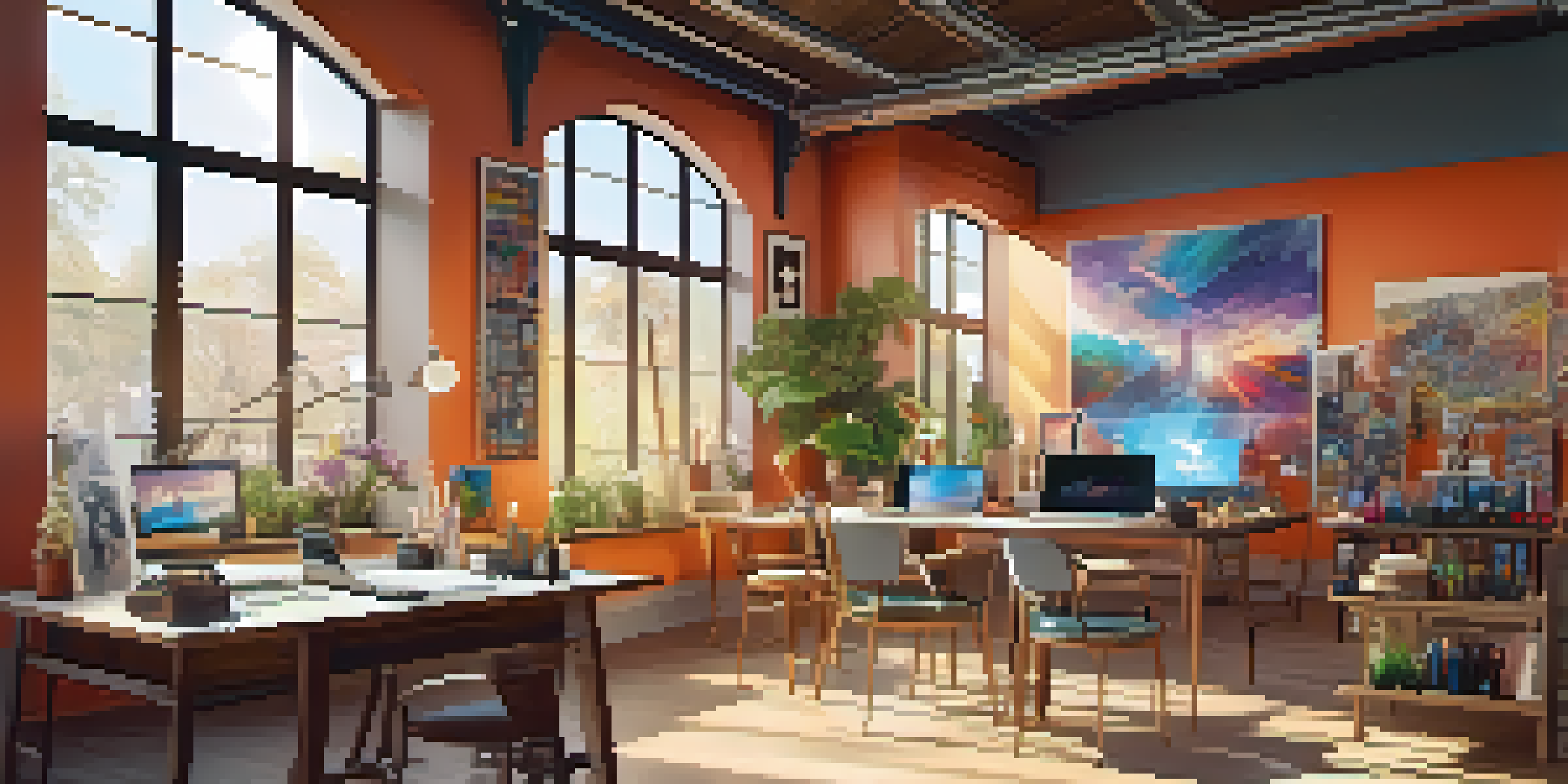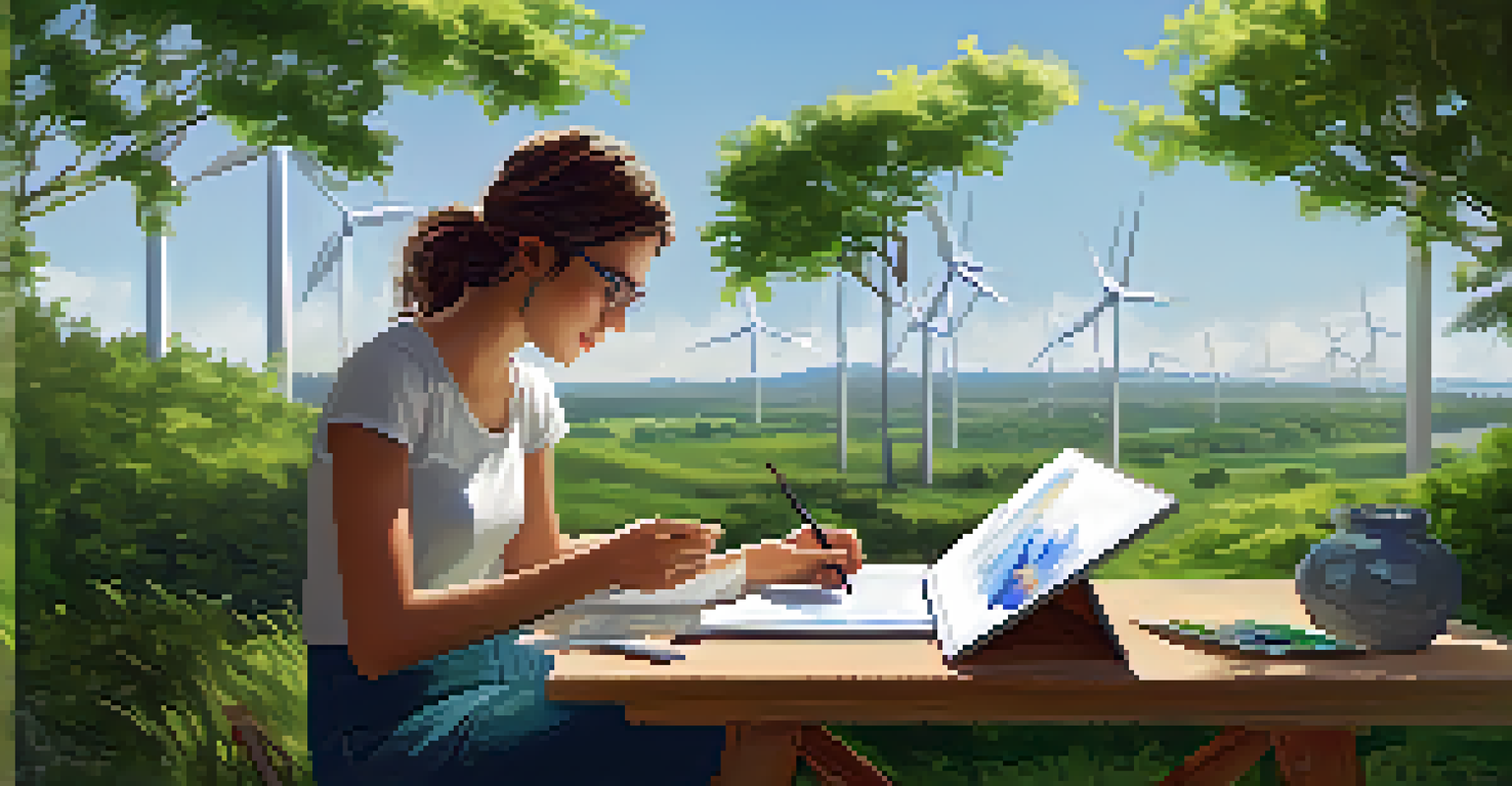Art and Technology: The Rise of NFTs in the Art Market

Understanding NFTs: A New Digital Art Form
NFTs, or Non-Fungible Tokens, are unique digital assets that represent ownership of a specific item or piece of art. Unlike cryptocurrencies such as Bitcoin, which are interchangeable, each NFT has distinct information that makes it one-of-a-kind. This uniqueness is what makes NFTs particularly appealing in the art world, as they can authenticate the originality of digital artworks.
Art is not a mirror held up to reality, but a hammer with which to shape it.
Imagine holding a rare baseball card; its value comes from the fact that it's not just another card but a distinct piece of memorabilia. NFTs function similarly, allowing artists to monetize their digital creations without the fear of forgery or duplication. This innovation has opened up a new revenue stream for artists, especially in an age where digital creations can be easily copied.
As more artists and collectors embrace NFTs, understanding their role in the art market becomes crucial. By bridging the gap between digital and physical art, NFTs are reshaping how we perceive value in art, making it a fascinating topic to explore.
The Intersection of Art and Technology
Art and technology have a long-standing relationship, but the rise of NFTs marks a significant evolution in this connection. From digital painting tools to virtual reality exhibitions, technology has continually transformed how artists create and share their work. NFTs take this further by integrating blockchain technology, which provides transparency and security in transactions.

Think of it like a digital gallery where every piece of art is not only displayed but also has a verified certificate of authenticity attached. This shift allows artists to reach a global audience, breaking down traditional barriers of entry in the art market. Consequently, artists can showcase their work without relying on galleries or auction houses.
NFTs Redefine Digital Art Ownership
NFTs provide a unique method for artists to authenticate and sell their digital creations, ensuring originality and reducing the risk of forgery.
The fusion of art and technology is not just a trend; it's a paradigm shift. By utilizing new tools and platforms, artists can innovate their practices and connect with audiences in ways that were previously unimaginable.
How NFTs Are Changing the Art Market Dynamics
The advent of NFTs has dramatically altered how art is bought and sold, creating a more democratized marketplace. No longer are collectors limited to traditional art fairs or galleries; they can now browse and purchase art directly from artists online. This shift allows for more diverse voices in the art community and increases accessibility for potential buyers.
The artist is the creator of beautiful things. To reveal art and conceal the artist is art's aim.
Consider the rise of online marketplaces like OpenSea and Rarible, where artists can list their NFTs for sale. This democratization means that even emerging artists can gain recognition and sell their work without the backing of major institutions. Consequently, the art market becomes less exclusive and more inclusive.
However, this new landscape also brings challenges, such as market saturation and fluctuating values. As more artists enter the NFT space, the question arises: how do collectors determine the worth of a digital piece? Navigating this evolving market requires both artists and buyers to stay informed and adaptable.
The Role of Social Media in NFT Art Promotion
Social media platforms have become pivotal in promoting NFT art, offering artists a direct channel to engage with their audience. Platforms like Twitter and Instagram allow artists to showcase their work, share their creative processes, and connect with potential buyers. This online presence not only builds brand loyalty but also fosters community among artists and collectors.
Imagine scrolling through your feed and discovering a digital artwork that captivates you. With just a click, you can learn more about the artist and even purchase the piece as an NFT. This immediacy and accessibility are game-changers for the art market, blurring the lines between exhibition and purchase.
Art Market Becomes More Accessible
The emergence of online NFT marketplaces allows a diverse range of artists to reach global audiences, democratizing art sales beyond traditional galleries.
Moreover, social media serves as a powerful marketing tool, amplifying the reach of NFT art. Artists can leverage viral trends and hashtags to increase visibility, making it easier for collectors to discover new talent and invest in unique pieces.
Environmental Concerns Surrounding NFTs
While NFTs have created exciting opportunities in the art world, they also raise significant environmental concerns. The majority of NFTs are minted on blockchain networks that use a proof-of-work consensus mechanism, which consumes vast amounts of energy. This energy-intensive process has sparked debates about the ecological impact of digital art.
Think of it like the difference between a traditional factory and a renewable energy source; one is sustainable, while the other can be harmful to the planet. As artists and collectors become more aware of these issues, many are seeking alternative platforms that prioritize eco-friendliness and sustainability in the creation of NFTs.
This growing awareness is prompting changes in the industry. Artists are advocating for greener practices, and blockchain developers are exploring more sustainable options, such as proof-of-stake systems. Balancing innovation with environmental responsibility will be key to the future of NFTs in the art market.
Legal Implications of NFT Art Sales
The rise of NFTs has also brought forth complex legal implications in the art world. Ownership of an NFT does not necessarily confer copyright of the artwork, leading to confusion about rights and usage. Artists and buyers must navigate these legal waters to understand what ownership truly means when it comes to digital art.
Consider the analogy of purchasing a physical painting: owning the artwork doesn’t automatically grant you the right to reproduce it for commercial purposes. Similarly, when buying an NFT, it’s vital to clarify the extent of ownership rights and any restrictions that may apply. This complexity highlights the need for clear communication between artists and collectors.
Environmental and Legal Challenges Ahead
Despite their potential, NFTs raise significant environmental concerns and legal complexities regarding ownership rights and sustainability.
As the NFT space continues to grow, legal frameworks will need to evolve to address these challenges. Artists, collectors, and legal experts must work together to establish guidelines that protect the rights of creators while ensuring fair practices in the marketplace.
The Future of NFTs in the Art World
Looking ahead, the future of NFTs in the art world appears promising and filled with potential. As technology continues to evolve, we can expect even more innovative applications of NFTs, such as virtual galleries and immersive art experiences. These advancements will likely redefine how audiences interact with and appreciate art.
Imagine attending a virtual exhibition where you can explore stunning digital art pieces in an immersive environment. This kind of experience could become commonplace, offering new ways to engage with art on a global scale. The possibilities are vast, and artists are just beginning to scratch the surface of what NFTs can offer.

While there are challenges to overcome, such as environmental concerns and legal complexities, the enthusiasm surrounding NFTs suggests a vibrant future. As artists and collectors navigate this evolving landscape, the blend of creativity and technology will continue to inspire and transform the art market.